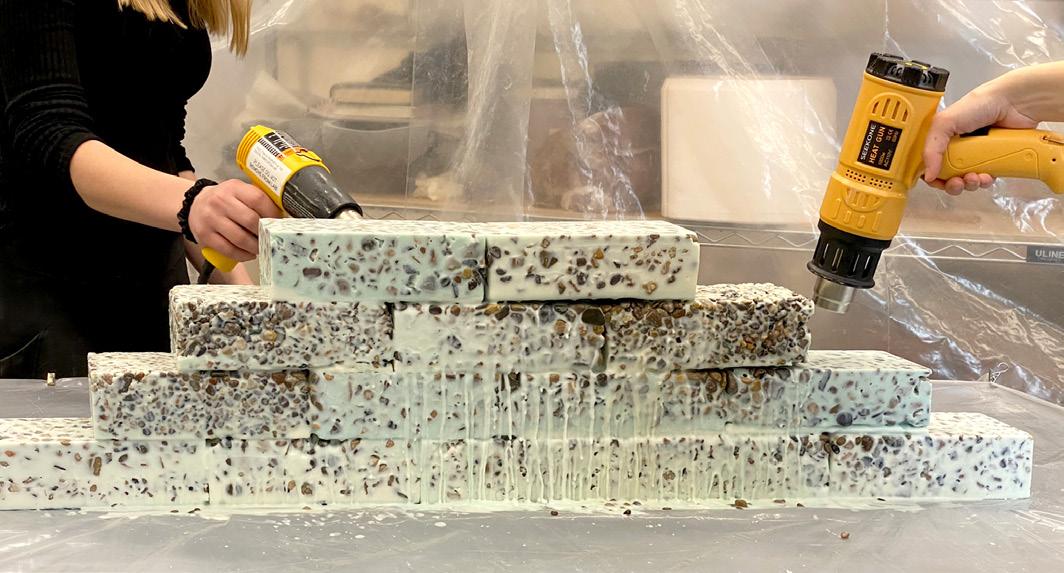
4 minute read
Entropy 2020, Meredith Miller
Entropy 2020
Meredith Miller
Advertisement
Left, the raw materials necessary for a 10 brick batch: soy-wax, gravel aggregate, lavender essential oil, and aquamarine dye chunks. Hot gases rise. Ice melts at 32°F. If I fill my coffee mug with boiling water first, and allow heat to transfer from the water to the thermal mass of the ceramic walls, then my coffee will cool off more slowly. Predictable patterns of thermal behavior provide the basis for so much of our daily functioning. At this precarious moment in human history (pre-election, mid-pandemic, full-swing-anthropocene), some may find reassurance in the constancy of thermodynamics…. I do.
On my shelf sits a small but surprisingly heavy object made of light-green tinted wax and dark stone aggregate. Its squared edges and brick-like proportions lend it a similar range of affordances as that of a brick. One could stack up with others into a wall. Or sail through a pane of plate glass. To me, though, this brick says less of what it “wants to be” and more of the thermodynamic conditions of its making. This side of its story features two stockpiles of different materials (wax and stones), the environment in which they came to mingle, and an influx of enough energy to assert a higher degree of order, if only temporarily. I say temporarily because we know from the second law of thermodynamics that closed
systems of matter and energy tend toward disorder. Robert Smithson memorably illustrated the irreversible vector of entropy in his description of a sandbox with white sand in one half and black sand in the other. A child runs in clockwise circles until the sand mixes into gray. If the child were to start running counterclockwise, the sand would never sort itself back into ordered black and white piles. For (Im)Material Matters, Liz Gálvez’s vision at the outset was not just to make bricks, but to make bricks that would become wall that would become exhibition that would unbecome wall as its temporary state of order gave way to entropy. To do so, she choreographed irreversible vectors of exchange between matter and energy across two sites and two environments: the fabrication lab and the gallery.
Right, a full-scale mockup used heat to fuse soy-wax and aggregate bricks together. The system uses no mortar, but rather relies on gravity to allow for a higher wax density towards the bottom of each brick.
At the center of the first energetic system is the brick’s maker, Gálvez, who over the course of several weeks cultivated an attention to subtle thermal variables within the system that could impart physical differences to the bricks. The specified soy wax blend, manufactured for melting, will not burn, but softens at 115°F and begins to melt at 120°F. If the ambient air temperature in the fabrication lab was too low, the rocks would cool the surrounding hot wax upon contact. If the heated mixture went into the molds without losing some heat to its atmosphere first, the viscosity of the wax would be too liquid to support an even scattering of the aggregate.
Producing hundreds of bricks out of wax and stone required a finely tuned awareness of these discrete moments of heat transfer and the ability to predict the resulting behavior. This accumulated material knowledge is not an end for Gálvez but a means for design.
The second site hosts another round of energetic inputs, with Gálvez at first supplying the manual labor for stacking and the convective energy of a heat gun to meld the courses into walls. From here her design anticipates another energetic system but without her regulating inputs—the deliberate arrangement of matter now left vulnerable to new thermal inputs. The interior air temperature of the space would not likely reach the melting point of the soy wax on its own, at least at this stage of planetary warming. But perhaps with enough warm bodies, a crowded exhibition opening might produce micro-environments capable of softening a few edges or leaving a detectable slump at the end of the night. Intervals of convective heat applied by gallery staff will
expedite the process, like the kid running clockwise in the sand in fast forward. However, between these two sites and their distinct temporalities came an unexpected turn involving a much larger system of material and energetic exchange. Viral particles have swept across the world’s human population, causing extensive illness and death. In addition to the public health crisis, the pandemic has also resulted in the canceling of all manner of events and a generally upended state of life in 2020. For this project, the pandemic introduced a longer incubation period between its conception and installation. The bricks now travel to the gallery, but many of the people who may have done so to see the exhibition will only witness it through images on social media or through this publication. The audience who might have filled the space during an opening celebration will remain “together apart,” as they say now, with a subset of IRL visitors spread apart and exhaling warm air into masks. For longer periods the walls will stand undisturbed by hands or heat.
In a strange reversal of the pandemic’s typical pattern of disruption, one of its effects here is that the wax brick walls might maintain a prolonged state of order compared to the designed entropy Gálvez had intended. Those straight edges and even peppering of rock, which register a careful calibration viscosity and heat, may remain as a testament of the human bodies that are not there.
Above, a batch of soy-wax and aggregate bricks colored with aquamarine dye.










